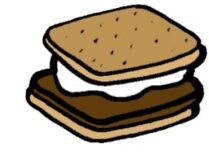
Overview
Title: Let’s Eat S’mores!
Grade: 4th Grade
Duration: 1 hour Lesson or 2x 45 Minute Lessons
Standards
Science – SC.4.E.6.6.
Identify resources available in Florida (water, phosphate,oil, limestone, silicon, wind, and solar energy).
Hypothesis
How does the design of a solar oven affect the transformation of radiant energy to thermal energy?
Vocabulary
Natural • Resource • Solar Energy • Thermal Energy • Absorbs • Fair • Converts • Gas • Heat • Light • Radiant • Energy • Reflection • Transforms
Essential Question
- Is Florida’s SUN a natural resource?
- Can the sun be used as a source of energy for cooking food?
Background Information
Solar ovens use solar energy—light and heat emitted from the Sun—to cook food. How does a solar oven work? The simple answer is that it is designed to absorb more heat than it releases.
The solar oven you will build in this activity is a relatively simple one made out of a pizza box, aluminum foil, plastic wrap and a sheet of black paper. You will cut a flap out of the pizza box’s lid and line this flap with aluminum foil. This will reflect sunlight into the box.You’ll also seal the opening with plastic wrap.
This plastic “window” works like a greenhouse roof, allowing (direct and reflected)sunlight to pass into the box, while also retaining heat. At the bottom of the box, you will place black paper. This will act as a heat sink that absorbs direct and reflected sunlight to warm it, which will heat food placed on top of it.
This activity also includes instructions for making a tasty s’mores treat that you can heat up in your own solar oven!
Guided Questions
- What is energy?
- How do we harness energy from the Sun?
- Can we store the energy from the Sun?
Materials
- 1 Small pizza box (one per group)
- Plastic wrap
- Aluminum foil
- 1 Wooden skewer (12”-18”)
- Ruler
- Masking tape
- 1 Paper Plate (a dark-colored one would work best if not use black construction paper to cover plate)
- Black construction paper
- Oven thermometer
- Scissors
- Marker
Food to cook
- Graham Cracker
- Chocolate Bar
- Marshmallow
Procedure
You will need to conduct this experiment on a fairly warm sunny day above 85 degrees Fahrenheit or even hotter. If you are in Florida then that would be almost any day
- On the top of the pizza box, use your marker to draw a square with edges spaced 1” from all sides of the box.
- Use scissors to cut along the sides and front edge of the lid, leaving the fourth side along the box’s hinge uncut.
- Tape aluminum foil to the inside surface of the new flap you just cut, shiny side visible. This is to reflect sunlight into the box. Smooth out any wrinkles that might occur.
- Tape plastic wrap to the original box flap so that it covers the hole you cut into the flap. Seal all four of the edges with tape.
- Tape black construction paper to the bottom inside of the box. This will help absorb the incoming sunlight.
- Cover any air leaks around the box edges with tape, making sure that the box can still be opened to place food inside or remove it later.
- Go outside in the sunlight and place the solar oven on a level flat surface.
- Place food items on a paper plate and place it inside the oven. Put the oven thermometer inside the oven where you will be able to see it without moving the oven.
- Tape one end of a wooden skewer to the reflector lid, and attach the other end to the box to adjust reflector.
- Let the food cook and periodically check the reflector angle to make sure sunlight is getting inside the oven.
Prepare the S’more in Advance
- Cut the graham cracker in half, place a marshmallow, and small piece of chocolate between the cracker halves.
- After, place the prepared s’more on a small square of aluminum foil that is slightly larger than the s’more (Using it as a tray) and put it in your solar oven on top of the black sheet of paper.
- Put the solar oven outside where it will get full, direct sunlight for at least 30 minutes and keep it turned so that the flap faces the sun. When the marshmallow is soft, it’s time to eat!
